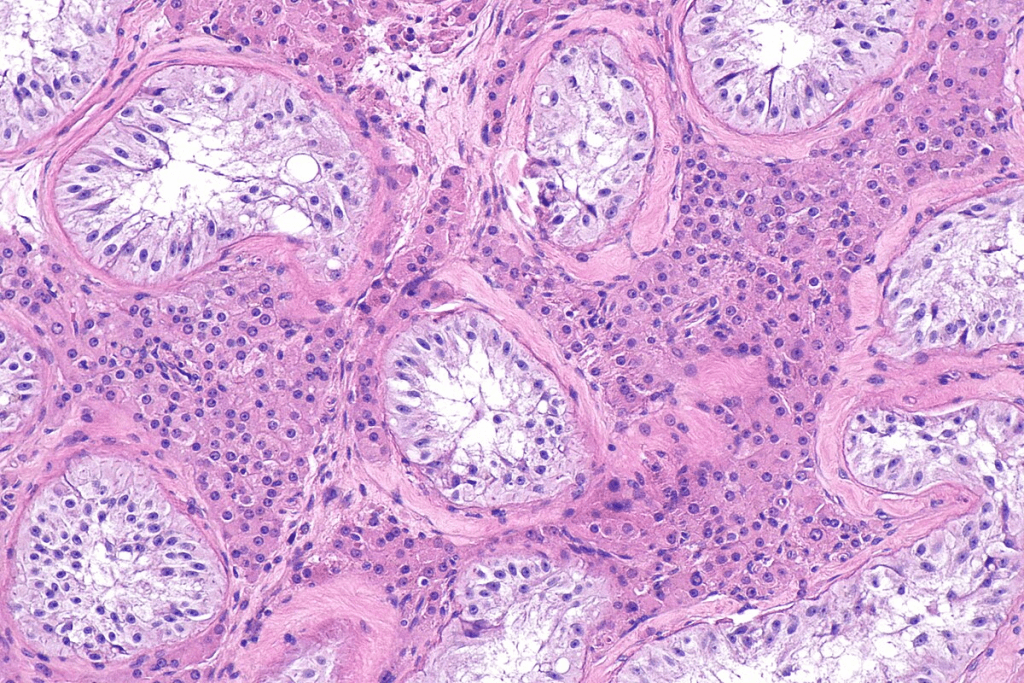Last Updated on November 25, 2025 by
Benign Prostatic Hyperplasia (BPH), also known as an enlarged prostate, affects millions of men globally. As men get older, the chance of getting BPH grows. By the 50s, nearly 50% of men are affected. By the 70s, this number jumped to 80%.

Even though a permanent “cure” for BPH might not exist, there are many ways to ease symptoms. We’ll look at treatments like Flomax, small procedures, and surgeries.
New treatments like aquablation, prostatic urethral lift, and prostate artery embolization show promise. They offer hope to men dealing with BPH.
Men with urinary issues often have an enlarged prostate. BPH is when the prostate grows too big. This can cause many urinary problems.

The prostate gets bigger with age, mainly because of hormone changes. Hormones like testosterone turn into DHT, which makes prostate cells grow. This can block the urethra and make it hard to pee.
As men get older, the chance of getting BPH goes up. It’s a common issue for older men. Hormones, genes, and other factors all play a part in why the prostate grows.
BPH is very common, hitting many men as they age. About 50% of men in their 50s have BPH. By their 80s, this number jumps to around 80%.
This shows how important it is for men to know about BPH as they get older.
Knowing the signs of an enlarged prostate is vital. Symptoms include weak or interrupted urine flow, needing to pee a lot, trouble starting to pee, and not being able to pee all the way out.
These symptoms can really affect a man’s life. Getting checked by a doctor is key if you’re experiencing these issues.
The idea of a ‘cure’ for an enlarged prostate is often misunderstood. It’s key to understand what it means for men with BPH. While treatments can help, finding a complete cure is not simple.
Benign Prostatic Hyperplasia (BPH) makes the prostate gland grow, causing urinary problems. The causes of BPH are complex, including age, hormonal changes, and genetics. This makes finding a cure hard.
BPH is not easy to “cure” because it involves many factors. The prostate gland grows with age in many men. Treatments can help, but they might not get rid of BPH completely.
Managing BPH means setting realistic goals. We focus on controlling symptoms and improving life quality. Treatments and lifestyle changes can greatly help.
Men with BPH should know that a complete cure might not be possible. But effective management can greatly improve symptoms and well-being. Working with healthcare providers helps create a treatment plan that meets individual needs.
The International Prostate Symptom Score (IPSS) helps measure urinary symptoms of BPH. It looks at symptoms like frequency, urgency, and weak stream. This score shows how well treatments are working.
We use IPSS scores to check if treatments are effective. A lower IPSS score means symptoms are better. This way, we can see how well treatments are doing.

Flomax and other alpha blockers are key in treating BPH symptoms. They help ease discomfort and urinary issues caused by an enlarged prostate.
Alpha blockers, like Flomax (tamsulosin), Terazosin, Alfuzosin, and Silodosin, relax prostate and bladder muscles. This makes it easier to urinate, reducing symptoms like weak flow and frequent need to go. They improve urine flow, boosting men’s quality of life with BPH.
Alpha blockers help symptoms but don’t fix the prostate size issue. They’re often the first choice because they work well.
5-alpha reductase inhibitors shrink the prostate over time. Drugs like finasteride and dutasteride block DHT, a hormone that makes the prostate grow. This reduces prostate size, easing BPH symptoms.
These inhibitors take longer to show results, often several months. But, the benefits can be significant for many men.
Cardura (doxazosin) is another alpha blocker for BPH. It relaxes prostate and bladder muscles like Flomax. The right choice depends on the patient’s needs and side effects.
Combining medications can offer both quick relief and long-term benefits. For example, using an alpha blocker with a 5-alpha reductase inhibitor can help with both symptoms and prostate size.
Medicines like Flomax and 5-alpha reductase inhibitors help manage BPH. But, they have side effects and not everyone gets relief. It’s important for patients to work with their doctor to find the best treatment.
Medical therapy is a big part of BPH care, giving many men relief and better quality of life. But, lifestyle changes and other treatments are also important for a complete care plan.
Men with an enlarged prostate have new, less invasive treatments. These methods can greatly reduce symptoms and improve life quality. They also help you recover faster.
The Prostatic Urethral Lift (PUL) lifts the prostate away from the urethra. This improves urine flow. It’s known for its effectiveness with few side effects.
Benefits include quick recovery and no harm to sexual function. It’s done under local anesthesia, perfect for those avoiding big surgeries.
Aquablation uses a waterjet to remove prostate tissue. It’s a heat-free, robotic therapy. It aims to reduce symptoms with fewer risks.
This method is precise. It removes tissue that blocks urine flow while keeping other areas safe. This lowers the chance of problems like incontinence and sexual issues.
Prostate Artery Embolization (PAE) stops blood flow to the prostate. This makes it shrink. It’s done by radiologists using a catheter to block blood flow.
This method is great for those at high risk for surgery or who didn’t get better with other treatments.
These treatments lead to big improvements in BPH symptoms over time. For example, one study showed a drop in IPSS scores from 23 to 7 in five years. This is a big win for symptom relief.
The long-term success of these treatments offers hope. They can greatly enhance a man’s quality of life for years.
Men with advanced Benign Prostatic Hyperplasia (BPH) may find relief through surgery. When other treatments don’t work, surgery is often the next step.
TURP is a common surgery for BPH. It removes prostate tissue that blocks urine flow. Many patients find it effective.
Key benefits of TURP include:
Laser therapies are a newer option compared to TURP. They use laser energy to shrink or remove prostate tissue.
Laser therapy offers several advantages, including:
Open prostatectomy is for men with very large prostates or complex cases. It’s a more invasive surgery.
As one study noted, “Open prostatectomy remains a viable option for patients with complex BPH cases.”
Modern surgery reduces the risks of incontinence and sexual problems. Surgeons aim to preserve urinary and sexual function.
“Advances in surgical techniques have made it possible to treat BPH effectively while minimizing the risk of long-term side effects.” “ A Urologist
Understanding surgical options can help men with advanced BPH make better choices. This can improve their quality of life.
Changing your lifestyle can help manage enlarged prostate symptoms. Making specific changes can ease discomfort from Benign Prostatic Hyperplasia (BPH).
Diet is key in managing BPH symptoms. Eating more fruits, vegetables, and whole grains supports prostate health. Foods high in antioxidants, like tomatoes, and omega-3s in fish, are good choices. It’s wise to cut down on caffeine and alcohol as they worsen urinary issues.
Regular physical activity and a healthy weight are vital. Exercise boosts urinary flow and lowers the risk of other health problems. Good exercises include brisk walking, cycling, or swimming.
Controlling fluid intake is key to less nighttime urination. Drink less in the evening and avoid caffeine and alcohol. Also, keep an eye on how much you drink to meet your needs.
Some men use natural supplements for BPH symptoms. Saw palmetto and beta-sitosterol might help. But, talk to a doctor before trying them, as they can interact with other meds.
By making these lifestyle changes, men with BPH can feel better. Always talk to a healthcare professional before making big changes.
Living with BPH can be tough, but the right treatment and lifestyle changes can help a lot. Men can improve their life quality by managing their enlarged prostate. This might include medicines like Flomax, small procedures, or surgery.
Men with BPH can make smart choices about their care. This helps them manage symptoms and live better. It’s important to work with a healthcare provider to find the best treatment.
Changing your diet, exercising, and managing fluids can also help. These lifestyle changes can greatly reduce BPH symptoms. With the right management, men can feel much better and live well.
By being proactive, men can take back control of their lives. They can live comfortably with BPH.
BPH, or an enlarged prostate, is a non-cancerous condition. It makes the prostate gland grow bigger. This can cause urinary symptoms.
Symptoms include a weak urine flow and needing to urinate often. You might also wake up at night to use the bathroom. Starting or stopping urination can be hard, too.
A complete cure for BPH is rare. But treatments like medications and lifestyle changes can manage symptoms well.
Alpha blockers, like Flomax, relax the prostate and bladder muscles. This improves urine flow and reduces symptoms.
These inhibitors help shrink the prostate gland. This reduces symptoms over time.
Making dietary changes and exercising regularly can help. Managing your weight and fluid intake is also key. Some natural supplements might also be helpful.
Procedures like prostatic urethral lift offer effective relief. They have fewer complications and quicker recovery than traditional surgery.
Surgery, like TURP, is needed for advanced BPH cases. This is when other treatments have failed or aren’t suitable.
Success is measured with the International Prostate Symptom Score (IPSS). It checks the severity of urinary symptoms.
Untreated BPH can cause urinary retention and bladder damage. It also increases the risk of urinary tract infections.
Yes, seeing a healthcare provider is key. They can diagnose and discuss treatment options that fit your needs.
Subscribe to our e-newsletter to stay informed about the latest innovations in the world of health and exclusive offers!